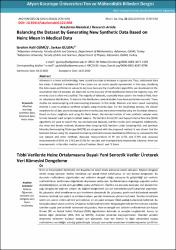| dc.contributor.author | Güldal, Serkan | |
| dc.contributor.author | Gümüş, İbrahim Halil | |
| dc.date.accessioned | 2023-09-14T10:50:54Z | |
| dc.date.available | 2023-09-14T10:50:54Z | |
| dc.date.issued | 30.06.2022 | en_US |
| dc.identifier.citation | Gümüş, İ. H. & Güldal, S. (2022). Balancing the Dataset by Generating New Synthetic Data Based on Heinz Mean in Medical Data . Afyon Kocatepe Üniversitesi Fen Ve Mühendislik Bilimleri Dergisi , 22 (3) , 570-576 . DOI: 10.35414/akufemubid.1011058 | en_US |
| dc.identifier.issn | 2149-3367 | |
| dc.identifier.uri | https://dergipark.org.tr/tr/pub/akufemubid/issue/71191/1011058 | |
| dc.identifier.uri | https://hdl.handle.net/11630/11019 | |
| dc.description.abstract | Advances in science and technology have caused data sizes to increase at a great rate. Thus, unbalanced data has arisen. A dataset is unbalanced if the classes are not nearly equally represented. In this case, classifying the data causes performance values to decrease because the classification algorithms are developed on the assumption that the datasets are balanced. As the accuracy of the classification favors the majority class, the minority class is often misclassified. The majority of datasets, especially those used in the medical field, have an unbalanced distribution. To balance this distribution, several studies have been performed recently. These studies are undersampling and oversampling processes. In this study, distance and mean based resampling method is used to produce synthetic samples using minority class. For the resampling process, the closest neighbors for all data points belonging to the minority class were determined by using the Euclidean distance. Based on these neighbors and using the Heinz Mean, the desired number of new synthetic samples were formed between each sample to obtain balance. The Random Forest (RF) and Support Vector Machine (SVM) algorithms are used to classify the raw and balanced datasets, and the results were compared. Additionally, the other well known methods (Random Over Sampling-ROS, Random Under Sampling-RUS, and Synthetic Minority Oversampling TEchnique-SMOTE) are compared with the proposed method. It was shown that the balanced dataset using the proposed resampling method increases classification efficiency as compared to the raw dataset and other methods. Accuracy measurements of RF are 0.751 and 0.799 and, accuracy measurements of SVM are 0.762 and 0.781 for raw data and resampled data respectively. Likewise, there are improvements in the other metrics such as Precision, Recall, and F1 Score. | en_US |
| dc.description.abstract | Bilim ve teknolojideki ilerlemeler veri boyutlarının büyük hızda artmasına neden olmuştur. Böylece dengesiz veriler ortaya çıkmıştır. Sınıflar neredeyse eşit olarak temsil edilmiyorsa, bir veri kümesi dengesizdir. Bu durumda sınıflandırma algoritmaları veri setlerinin dengeli olduğu varsayımı ile geliştirildiği için verilerin sınıflandırılması performans değerlerinin düşmesine neden olur. Sınıflandırmanın doğruluğu çoğunluk sınıfını desteklediğinden, azınlık sınıfı genellikle yanlış sınıflandırılır. Özellikle tıp alanında kullanılan veri kümelerinin çoğu dengesiz bir dağılıma sahiptir. Bu dağılımı dengelemek için son zamanlarda çeşitli çalışmalar yapılmıştır. Bu çalışmalar, eksik örnekleme ve aşırı örnekleme süreçleridir. Bu çalışmada, azınlık sınıfı kullanılarak sentetik örnekler üretmek için uzaklık ve ortalama tabanlı yeniden örnekleme yöntemi kullanıldı. Yeniden örnekleme işlemi için, azınlık sınıfına ait tüm veri noktaları için en yakın komşular Öklid uzaklığı kullanılarak belirlendi. Bu komşulara dayalı olarak ve Heinz Ortalaması kullanılarak veri setini dengeye getirmek için her numune arasında istenilen sayıda yeni sentetik numuneler oluşturuldu. Ham ve dengeli veri setlerini sınıflandırmak için Rassal Orman (RF) ve Destek Vektör Makinesi (SVM) algoritmaları kullanıldı ve sonuçlar karşılaştırıldı. Ayrıca, iyi bilinen diğer yöntemler (ROS, RUS ve SMOTE) önerilen yöntemle karşılaştırılmıştır. Önerilen yeniden örnekleme yöntemini kullanan dengeli veri kümesinin, ham veri kümesi ve diğer yöntemlere kıyasla sınıflandırma verimliliğini artırdığı gösterilmiştir. Sırasıyla ham veriler ve yeniden örneklenmiş veriler için RF'nin doğruluk ölçümleri 0.751 ve 0.799'dur ve SVM'nin doğruluk ölçümleri 0.762 ve 0.781'dir. Aynı şekilde Kesinlik, Hassasiyet ve F1 Skoru gibi diğer metriklerde de iyileştirmeler vardır. | en_US |
| dc.language.iso | eng | en_US |
| dc.publisher | Afyon Kocatepe Üniversitesi | en_US |
| dc.identifier.doi | 10.35414/akufemubid.1011058 | en_US |
| dc.rights | info:eu-repo/semantics/openAccess | en_US |
| dc.subject | Machine Learning | en_US |
| dc.subject | Synthetic Data | en_US |
| dc.subject | Balanced Data | en_US |
| dc.subject | Heinz Mean | en_US |
| dc.subject | Makine Öğrenimi | en_US |
| dc.subject | Sentetik Veri | en_US |
| dc.subject | Dengesiz Veri | en_US |
| dc.subject | Heinz Ortalaması | en_US |
| dc.title | Balancing the dataset by generating new synthetic data based on heinz mean in medical data | en_US |
| dc.title.alternative | Tıbbi verilerde heinz ortalamasına dayalı yeni sentetik veriler üreterek veri kümesini dengeleme | en_US |
| dc.type | article | en_US |
| dc.relation.journal | Fen ve Mühendislik Bilimleri Dergisi | en_US |
| dc.department | Adıyaman Üniversitesi | en_US |
| dc.authorid | 0000-0002-4247-0786 | en_US |
| dc.authorid | 0000-0002-3071-1159 | en_US |
| dc.identifier.volume | 22 | en_US |
| dc.identifier.startpage | 570 | en_US |
| dc.identifier.endpage | 576 | en_US |
| dc.identifier.issue | 3 | en_US |
| dc.relation.publicationcategory | Makale - Ulusal Hakemli Dergi - Başka Kurum Yazarı | en_US |



















